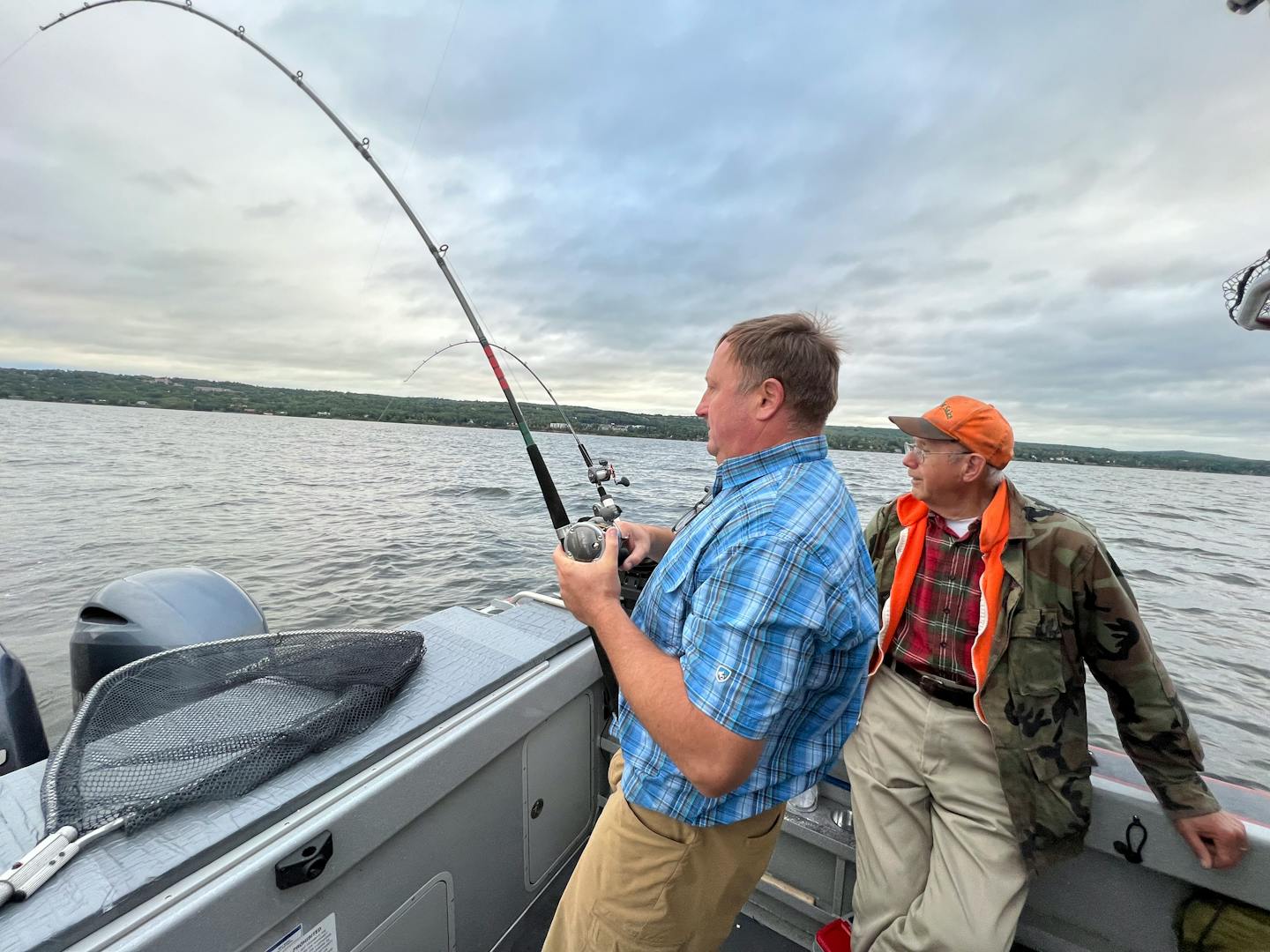 See
more of the story
See
more of the story
DULUTH — If there's a monument to Ramsay Crooks near the harbor here, the four of us didn't see it in the half-light of a recent early morning while passing beneath the lift bridge that separates Lake Superior from this city's more protected waters.
Crooks was president of the American Fur Co. in 1834, when his company began fishing the Big Lake commercially, the first to do so.
Lake trout were prevalent then, and whitefish, and by establishing fishing stations on what is now Minnesota's North Shore, and elsewhere around the lake, Crooks imagined earning big money from the same resource that, in legend, lore and fact, had for centuries supported the Chippewa, whose fishing nets were woven from the fibrous inner bark of willow trees.
Unlike Crooks' mercantile ambitions, our foray onto Lake Superior was recreational.
A few years back, on a whim of sorts, my friend Terry Arnesen had bought a larger boat than anyone in our bunch had owned. His intent, cockamamie as it might sound to some, was to launch the craft and bob in the direction of Alaska.
Which four summers ago he did, and did again this summer, trailering his 28-footer to Washington state, where he dropped it into the Pacific.
Soon after, he was texting me from Petersburg, Alaska, while grilling halibut on the aft deck, living large.
Now, as a follow-up adventure, beneath a dusky penumbra cast by the rising sun, we motored onto Lake Superior, hoping to learn more about how to catch fish on this clear, cold lake.
"Where do you think we should start?'' Terry said.
His question was cast toward Mark Strelnieks of the Twin Cities and Pete Harris of Grand Marais, seasoned Lake Superior anglers Terry and I had corralled for the outing.
Terry had met Mark by happenstance not long ago and had struck up a friendship over their mutual love of big water, and big-water fishing.
Pete, meanwhile, whose Minnesota street cred rivals that of Paul Bunyan, is a fellow I wrote about last year.
At 87, he fishes through the ice in winter, gathers hundreds of gallons of maple sap to distill in spring, and in summer regularly leaves the Grand Marais harbor in his vintage 14-foot boat to fish Lake Superior for lake trout.
Winding down his year, in November, while watching skim ice form along the Lake Superior shoreline, Pete fills his freezer with venison, stacking one cut after another, each wrapped neatly in white paper.
"My wife, Carol, and I keep a big garden, and the produce from it and the one deer will get us through the winter,'' he said.
Piloting his boat to within a mile or so of the Duluth shoreline, and parallel to it, Terry soon joined the approximate tack of a handful of other fishing craft, some charter, some private.
On each, deckhands were busy sending planing boards to port and starboard, attached to which were long lines that pulled flutter spoons or crankbaits. Then they dropped leaden downrigger balls to position still more baits nearer to the bottom.
Their goal, like ours, was to catch lake trout, salmon — or both.
"What's our depth?'' Mark asked.
"Ninety feet.''
Mark has fished Superior and also Lake Michigan for about six years, the endpoints of an angling career that has seen countless stops at Minnesota's best walleye lakes.
"Fishing these big lakes is a new challenge,'' he said. "What I like about it is that you're always meeting people and developing new relationships. My father and my nephew fish a lot with me, and oftentimes when we're putting our boat in at Two Harbors or Silver Bay or in Duluth, we'll meet people who are willing to help and share information.''
Terry's young dog, Fetch, was along for good luck, and by the time we had eight lines trailing the boat, the young Labrador was begging pets from a captive audience.
Soon thereafter, one of our shallower-running lines pulled tight, and Pete was handed a rod whose pulsating tip was telltale of a hooked fish — a coho salmon, as it turned out.
Though new to Lake Superior fishing and its many mystery gadgets — Dipsy Divers, flashers, underwater temperature and lure-speed sensors — Terry was experienced enough from his Alaska fishing adventures to mark on his electronics the spot where we hooked the salmon.
"We'll go back over it after a while,'' he said. "Maybe there'll be more there.''
When that proved true — we finished with eight fish in about eight hours, all lake trout except the initial coho, all taken from the same general area, and all but one on Pete's magic (though now out of production) Sutton Spoons — we felt clever enough.
But the advent of so many fish-finding accessories, and their widespread use, pressures the Lake Superior fishery, Department of Natural Resources managers say, especially in a water body that is perilously cold and relatively infertile.
Pete, in fact, is among those who believe Superior's trout numbers, at least those near Grand Marais, have declined in recent years, and the DNR management plan for Minnesota waters of Lake Superior acknowledges nearly countless challenges to these and other of the lake's fish.
A who's-who list of invasive plants and critters in Lake Superior is one problem. Habitat changes in the lake and its tributary streams are another. Climate change and limited management resources are two more issues. And sometimes the lake's native and introduced fish species compete and conflict.
Yet, at day's end, as we winched Terry's boat onto its trailer and Fetch the Labrador fell quickly asleep after a long, hard day of snoozing, those issues seemed as far off as the sun that soon ducked behind Duluth's hills.
For us, on this day, the legend had indeed lived on — as Gordon Lightfoot croons — from the Chippewa on down of the big lake they call Gitche Gumee.





